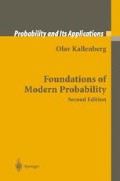Abstract
Conditional expectations and probabilities; regular conditional distributions; disintegration; conditional independence; transfer and coupling; existence of sequences and processes; extension through conditioning.
Access this chapter
Tax calculation will be finalised at checkout
Purchases are for personal use only
Preview
Unable to display preview. Download preview PDF.
References
Though conditional densities have been computed by statisticians ever since Laplace (1774), the first general approach to conditioning was devised by Kolmogorov (1933), who defined conditional probabilities and expectations as random variables on the basic probability space, using the Radon-Nikodym theorem, which had recently become available. His original notion of conditioning with respect to a random vector was extended by Halmos (1950) to general random elements and then by Doob (1953) to abstract sub-σ-fields.
Our present Hilbert space approach to conditioning, essentially due to von Neumann (1940), is more elementary and intuitive and avoids the use of the relatively deep Radon-Nikodym theorem. It has the further advantage of leading to the attractive interpretation of a martingale as a projective family of random variables.
The existence of regular conditional distributions was studied by several authors, beginning with Doob (1938). It leads immediately to the familiar disintegration of measures on product spaces and to the frequently used but rarely stated disintegration Theorem 6.4.
Measures on infinite product spaces were first considered by Daniell (1918–19, 1919–20), who proved the extension Theorem 6.14 for countable product spaces. Kolmogorov (1933) extended the result to arbitrary index sets. Lomnicki and Ulam (1934) noted that no topological assumptions are needed for the construction of infinite product measures, a result that was later extended by C.T. Ionescu Tulcea (1949–50) to measures specified by a sequence of conditional distributions.
The interpretation of the simple Markov property in terms of conditional independence was indicated already by Markov (1906), and the formal statement of Proposition 6.6 appears in Doob (1953). Further properties of conditional independence have been listed by Döhler (1980) and others. The transfer Theorem 6.10, in the present form quoted from Kallenberg (1988), may have been first noted by Thorisson.
The traditional Radon-Nikodym approach to conditional expectations appears in many textbooks, such as in Billingsley (1995).
Author information
Authors and Affiliations
Rights and permissions
Copyright information
© 2002 Springer Science+Business Media New York
About this chapter
Cite this chapter
Kallenberg, O. (2002). Conditioning and Disintegration. In: Foundations of Modern Probability. Probability and Its Applications. Springer, New York, NY. https://doi.org/10.1007/978-1-4757-4015-8_6
Download citation
DOI: https://doi.org/10.1007/978-1-4757-4015-8_6
Publisher Name: Springer, New York, NY
Print ISBN: 978-1-4419-2949-5
Online ISBN: 978-1-4757-4015-8
eBook Packages: Springer Book Archive

